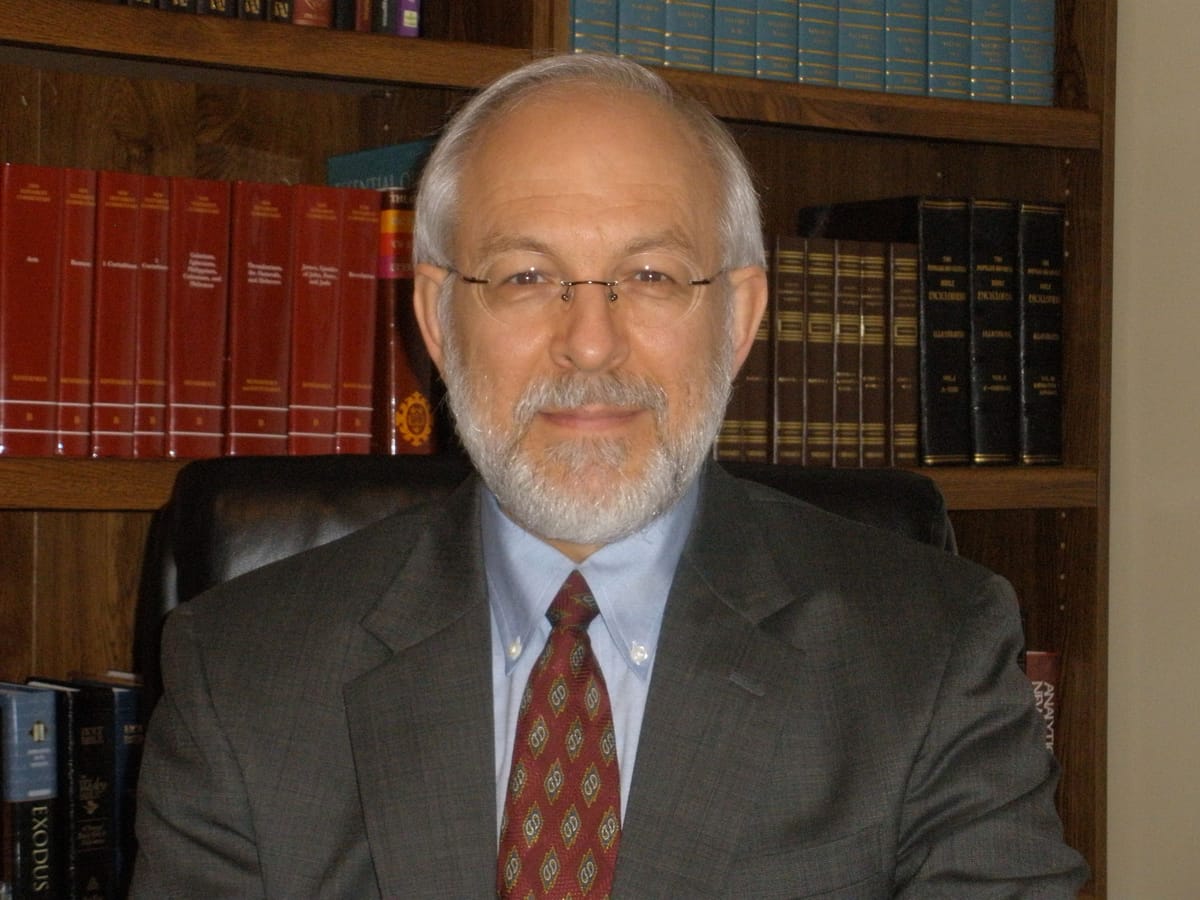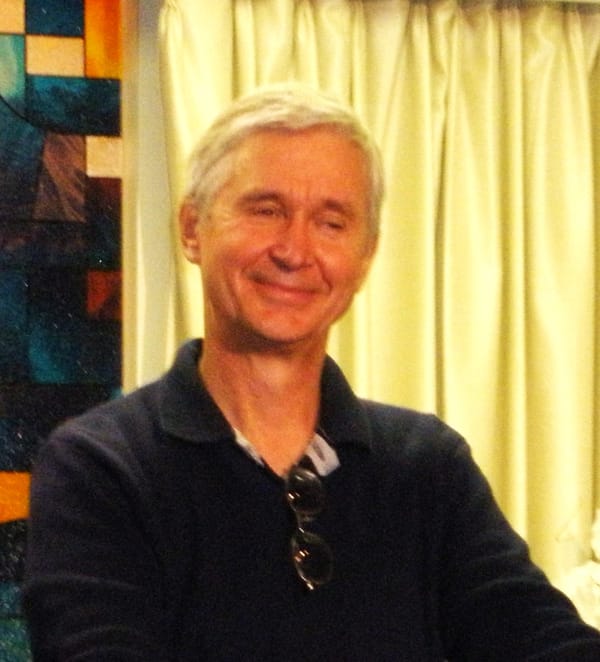The last part of the title has its origin in the mining industry, but it has become a catchphrase for a warning to “Watch out!” or “Heads up!”
My next tale from my experiences in Pardee Hospital begins on Tuesday a week ago, July 15th. Incidentally, while the use of the word “tale(s)” may sometimes imply fiction or myth, I assure you these are true stories, to the best of my recollection.
I already mentioned the difficulty of sleeping comfortably with an IV drip in my arm. I had neither eaten nor drank anything since the previous Sunday evening… with the exception of trying to swallow a sip of water on about six occasions from Sunday evening until I got to the ER early Monday morning. Each time I took a sip, it triggered an episode of the dry heaves.
By Tuesday early morning, I had been on the IV drip nonstop with both the antibiotic and saline going into my vein. The phlebotomist was there early to draw another vial of blood (another A+ for her expertise) from my other arm so they could test it immediately to see if my way-off-the-chart number of my pancreas function was down sufficiently to proceed with the ERCP later in the day.
The staff doctor came in shortly thereafter and explained that the surgery was a “go,” but they could not tell me exactly when because they were squeezing me in the surgeon’s already full slate for the day. He had ten other surgeries scheduled. It is likely they would try to get me in about noon, he said.
In my haste to get to the ER, I had totally neglected to bring any reading material, and did not want to risk bringing my laptop. I had my mobile phone, of course, but I almost never use it for anything online since it has no connection from my home office.
I began watching Fox News—reluctantly—as Newsmax was not available in the channel lineup. But as soon as I was caught up with the latest, I muted it until I was wheeled down to the Operating Room.
Somewhere around 11:30 a.m. as I had finished my daily morning prayers—with special requests for myself, I actually forget that sometimes—and I was merely cogitating about the future, when suddenly I hear a shrill sound. The heavy, solid-wood door to my room was closed, but I knew immediately it was a fire alarm.
I got out of bed and stretched my IV line which had just barely enough length to grab the door handle. I opened it just in time to hear the PA announcer say, “All facilities, code red, first floor, kitchen…I repeat…”
That was my first hint 😉that this was not a drill. All the staff were scurrying about and I deliberately left my door open. Having just stepped down a few months ago from my seat on the Board of Directors of the Fletcher Fire and Rescue Department, I knew what should happen.
The staff were well trained and within a minute one of the friendly staffers peeked in and said they had to close the door. I gave her a thumbs up, smiled and said, good job.
This being the real thing, I expected to hear the sounds of the Hendersonville Fire Department responding. The main station is about 6-8 blocks away and they were pulling in within about 3-4 minutes—excellent! Here are a couple of photos I shot from inside my third story window.
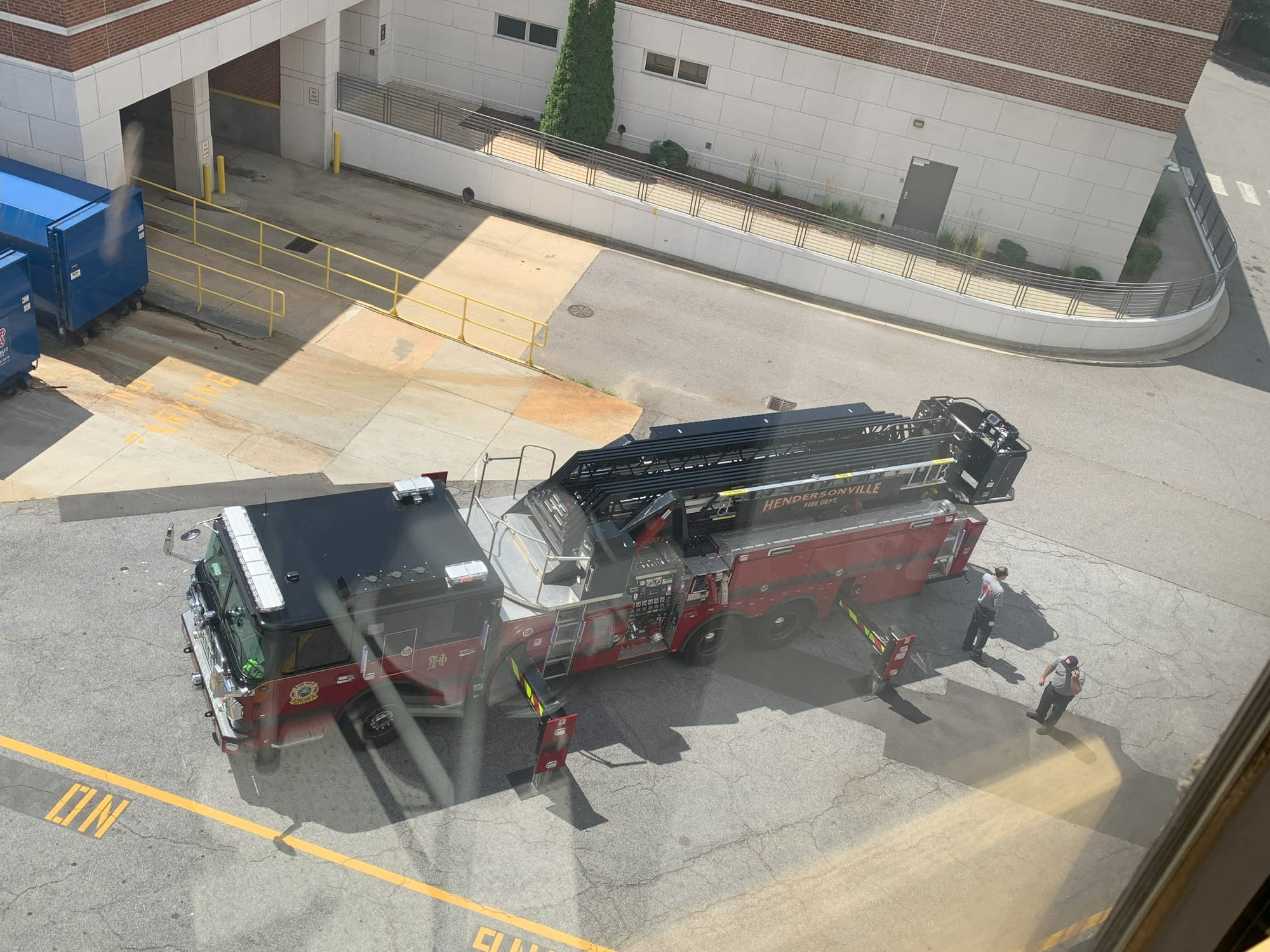
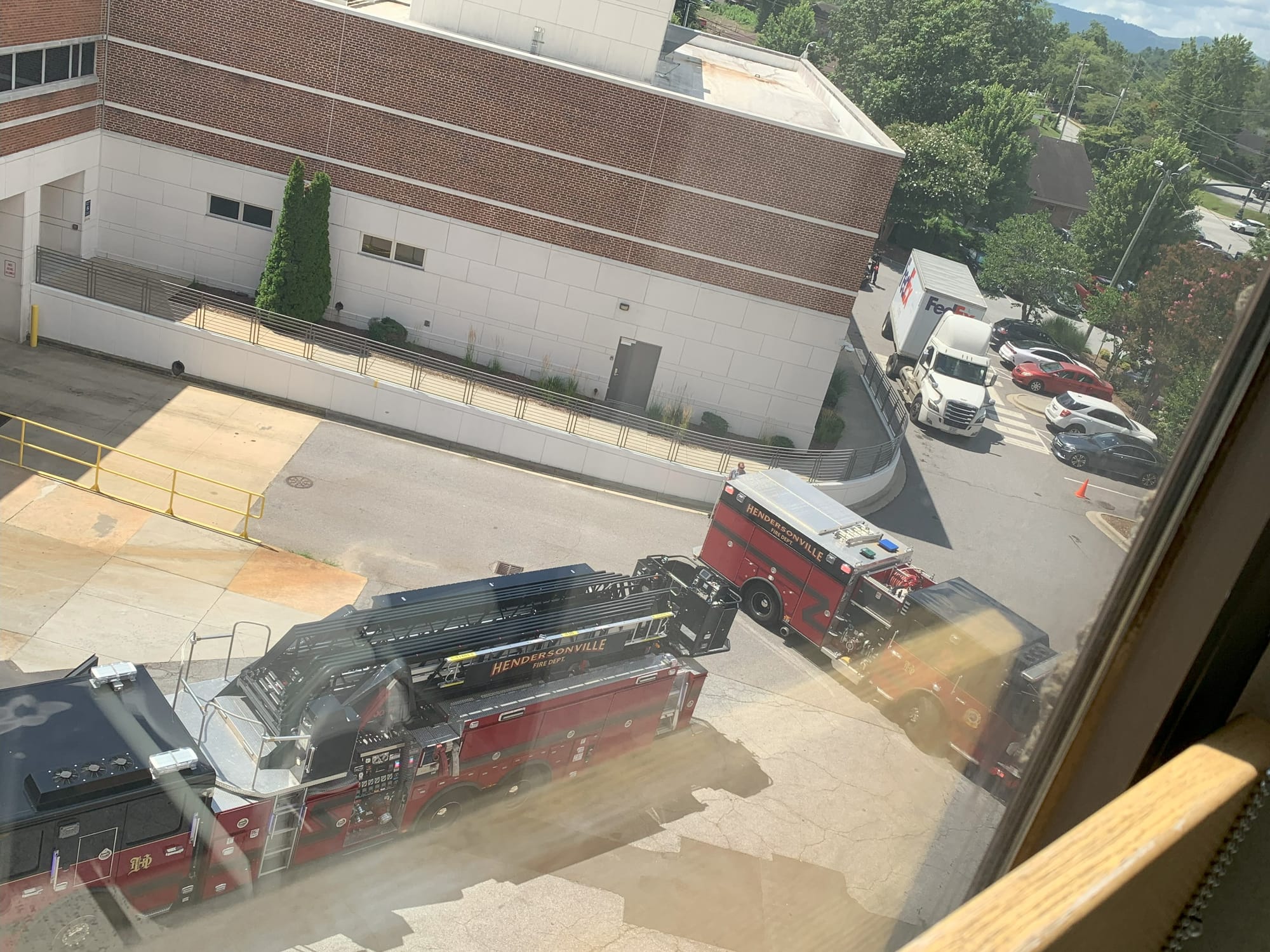
Within about 20 minutes, I saw the crews wrapping up, and departing. The PA announcer came on and announced the “all clear.” Later that evening (post-op), a fellow from the kitchen’s meal delivery crew showed up with my liquid diet (Jello—yuck, beef broth—yummy, and two 4 oz. cups of fruit juice—no sugar added).
I asked if he had been here at work during the “commotion” and fire in the kitchen earlier in the day. He said, no, so I filled him in and asked him if he could find out where in the kitchen the fire had been and what caused it. He assured me he would find out.
All commercial and industrial kitchen operations are usually required by government code to be equipped with fire suppression systems such as the big hoods over the cooking area that you can see in the kitchens of restaurants such as Carrabba’s where it’s out in the open for diners to see.
The next day (Wednesday) he came by twice to say he had asked around and did not have an answer but would keep trying. Finally, he came by just before I left to say he was told by his kitchen boss that basically, he did not have “the need to know.” I can understand that from a management perspective.
But to back up now to Tuesday noon. The fire department had just left, and as I looked out from my third story window and studied the equipment on the roof tops of the various wings of the hospital, I had a hunch that the kitchen on the first floor was directly below my room.
Finally, about 12:30 p.m. it was showtime. A bright, cheery, young (mid- to late-20s, I would guess) nurse came in and announced she was there to take me down to the first floor to the prep room located across from the suite of operating rooms.
As she was navigating my bed with the IV pole alongside, out the room, down the hall and waiting on the elevator, I asked her if she had heard about the fire (of course she had), and inquired of her if my room were not directly above the first floor kitchen. She paused for a couple seconds and then said, yes, it is, directly below your room.
When I asked her if she knew what caused the fire, she said she did not know, but wondered out loud if it might have been a microwave oven catching on fire. I replied that I doubted that a microwave would be the culprit, but I then expressed my amazement that an institution devoted to healing and health would have microwave ovens in the kitchen.
She looked puzzled and asked, What’s wrong with microwave ovens? From that point on until we arrived in the prep room, I instructed her on the dangers. For readers who may be unaware, the following may be helpful to you also.
First, I wanted to give her my qualifications to offer my opinions (everybody is entitled to have one on any issue), but why she might want to give added weight to my studied and life experience-based opinions on this topic.
You are quite young, I began, but did you know that when microwave ovens first came out, they were called and marketed as “Radar Ranges?” She did not know that. They were called that because the radar ranges operate in the same part of the electromagnetic (EM) spectrum as radar in general operates, I explained.
Back in the late 60s, I continued, I was trained in electronics—about 1200 classroom hours—about half to a third of those hours in classified training for me to know how to fix radar sets—huge radar sets.
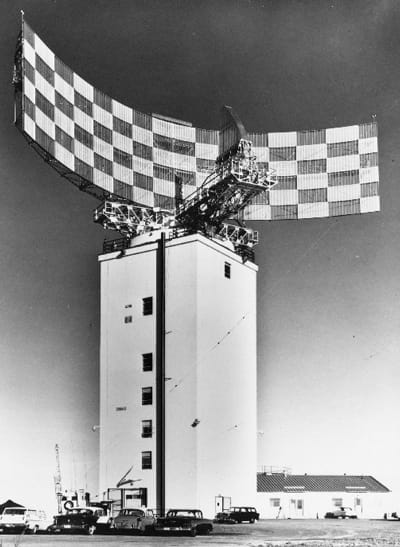
Then I worked my last three years in the U.S. Air Force in two locations (northern Michigan and Alaska) doing that work. So I do know a thing or two about radar, I assured her, and Pardee’s cancer treatment facility uses radiation, chemo and surgery as the standard treatment protocol, right? She nodded.
And, if the patient is not already bald, like me, what happens to most people who undergo radiation treatment?
They lose their hair, she replied.
Exactly, I agreed. And by the way, after being on my first assignment to a radar site in Sault Ste. Marie, Michigan for only about six months, when I shampooed my once glorious locks 😎, my hair was coming out in globs—not kidding! And while mine might have a family genetic component, to say I was alarmed is putting it mildly.
Because back in that 1200 hours of classroom instruction, we learned about what was called side-lobe radiation. In other words, while most of the power of the radar emitted bounces off the antenna and into the distance, there is some EM radiation that “leaks” around and behind the radar set—the side lobes. Not healthy, and hence, at least part of the reason for this fellow with a bald dome lying in this bed you are pushing down the hall to the OR.
She seemed to be following closely and very interested in me continuing. So how does this relate to microwave ovens specifically? she inquired.
Well, that involves the manner it which it cooks food. This gets into a bit of chemistry which I am sure you were trained in during your R. N. training. You see, take a nice batch of green beans freshly picked from your organic garden. They are full wonderful, life-giving vitamins and minerals, correct?
She nodded. The way that a microwave oven works in layman’s language is that the EM radiation waves stir up the chemicals in the food at the molecular and nuclear level. (Hence, I sometimes call it “nuking” the food.)
All the vitamins and minerals have chemical bonds which bind them together to create a given vitamin or mineral. The blasting of the food with the EM radiation creates friction which heats the “food,” but it also severs those chemical bonds, leaving the food being no longer food, but just a mass of material with virtually no food value left in it at all.
You may as well be eating a pile of soggy newspaper. It will fill you up, but your body is becoming malnourished. Is it any wonder that obesity plagues our American society?
She was receptive to the argument I had set forth, but then asked, what about using it just to heat up your coffee, or tea, or even water?
Same thing, I replied. It destroys the molecular bonds. As for water, there was an experiment done by some homeschoolers decades ago—and repeated by many other kids since then.
They took some seeds from the same batch, filled two pots with the same good soil, set them in the same location to receive the same amount of sunlight. In other words, as careful young scientists they were controlling for one variable.
Everything was exactly the same except that one potted plant received normal (non-chlorinated, non-fluoridated) water, and the other received the same amount of water except that it had been “nuked” and allowed to cool.
Over several weeks as the seeds sprouted and grew, the one with the normal water grew nicely and produced nice veggies. The other plant was clearly and seriously stunted in its growth. Draw your own conclusion.
By that time, she was wheeling me into the prep room whereupon she immediately began telling her fellow nurses and other staff concerning what she had just learned. She nodded to acknowledge me as the source of the information.
I was delighted that it had resonated (an EM term) with her and she had now become an apostle of “quit nuking my food.” I interjected for a moment to say to all of them,
“Look, back in the day, this information required some considerable effort to find. So, don’t take my word for it. You can do a web search and do your own homework in half an hour or less.”
Next time, in Tales from Pardee Hospital, I shall relate an incident that occurred while I was being prepped and signing papers. Oops, did I give away too much? No, but, that oops is a tease.
(To be continued.)
~END~

